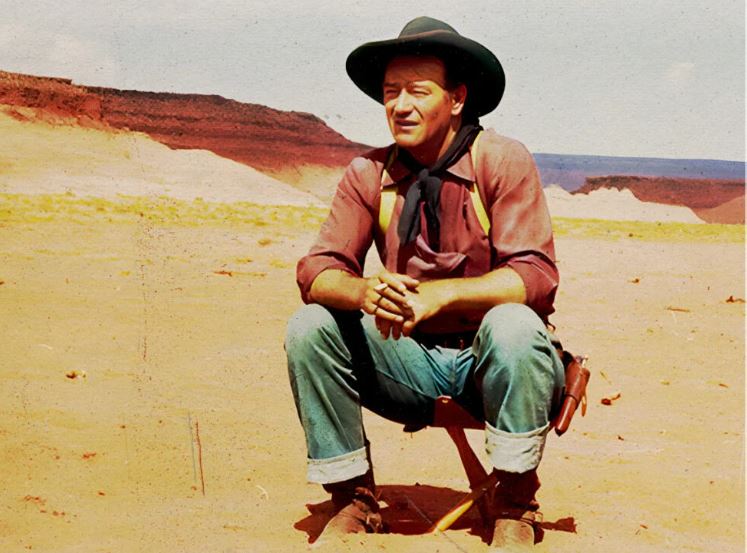Due to his continued dedication to honing his craft, John Wayne soon became synonymous with the western genre, closely working with John Ford on pictures such as The Searchers and The Man Who Shot Liberty Valance to create a legacy like no other. It is a testament ot his ability to command a screen that his legacy has lived on for as long as it has, considering he started making movies nearly a century ago.
Wayne was one of the biggest stars of the silver screen during Hollywood’s Golden Era, starring in over 170 films. His name still carries huge weight to this day, despite the fact that his abhorrent views are often brought back to the public’s attention. But his time as an actor could have never happened had his original plan of becoming a big-time football player come into effect.
After injuring himself in a bodysurfing incident, Wayne lost his university scholarship, and his sporting career was no longer viable, forcing him to withdraw from education. However, because his coach, Howard Jones, often gave western star Tom Mix free tickets to USC games, Ford and Mix returned the favour by hiring Wayne as a prop boy. This would be a vital moment for Wayne, giving him a taste of the industry and setting him up to begin a long and lasting career. Following several small or uncredited roles in silent films, he received his first leading role in 1930’s The Big Trail after director Raoul Walsh saw Wayne working behind the scenes.
Due to the commercial failure of The Big Trail, Wayne spent the early years of his career playing minor roles in big films or leading cheaply-made Poverty Row westerns. Within these films, he helped to pioneer the idea that good characters could fight with the same intensity as the bad guys. Wayne stated (via archive.org), “Before I came along, it was standard practice that the hero must always fight clean. The heavy was allowed to hit the hero in the head with a chair or throw a kerosene lamp at him or kick him in the stomach, but the hero could only knock the villain down politely and then wait until he rose. I changed all that. I threw chairs and lamps. I fought hard, and I fought dirty. I fought to win.”
His burgeoning influence on cinema was evident from the beginning, although it was not until 1939 that he truly broke into the industry with his role in Ford’s landmark western Stagecoach. Soon enough, Wayne was a symbol of machismo and personified the all-American man, conveying the ideals and values of his country. Emerging shortly before, during and after the war, Wayne’s position as an infallible hero, usually a cowboy of sorts, meant he operated as the ultimate distillation of Americana. His word was justice on screen, and while he may have fought to win, he did so with the morality of a man blessed by his country.
The actor once selected his favourite roles from his career in an interview with Phil Donahue in 1976. Of course, his first pick was the film that allowed him to emerge into the spotlight, Stagecoach. He stated, “I love Stagecoach naturally because I stepped on that stagecoach, and it carried me a long way.” The film was shot in Monument Valley in the Southwest of America and followed a group of stagecoach passengers, including Wayne’s Ringo Kid, who is picked up after his horse leaves him stranded. According to actor Louise Platt, in a letter recalling the film’s production, Ford believed that Wayne would become “the biggest star ever because he is the perfect ‘everyman’.”
It was a backhanded compliment that would land Wayne a permanent place in Ford’s heart. Though, much like how he praised the star, Ford also spent much time hurling abuse at Wayne and making fun of him for not serving in the Second World War. Although Stagecoach lost out on winning ‘Best Picture’ at the Academy Awards, it scooped up ‘Best Supporting Actor’ for Thomas Mitchell and ‘Best Score’.
Another of Wayne’s favourite films he starred in was Hatari! from 1962. Directed by Howard Hawks, Wayne appears as a game catcher in Africa. Shot in Tanganyika, now Tanzania, the film became the seventh highest-grossing movie of the year. Hatari! is not regarded as one of Hawks’ greatest films, a title much more likely to be given to another of his collaborations with Wayne – Rio Bravo.
Still, Wayne loved the film, although it appears that he loved the shooting location more than the final product. “I like Hatari! which was a picture we made in Africa because I had a three-month safari free. I mean, rich men don’t get that, you know.”
Finally, his last pick was Ford’s The Quiet Man, released in 1952. The romantic comedy follows Wayne’s Sean Thorton as he travels from Pittsburgh to his native Innisfree in Ireland to buy his family’s farm. Upon its release, Wayne was praised for his performance, although contemporary critics have noted that his character displays glaringly misogynistic attributes through his exertion of control over the women around him. Ford won the ‘Best Director’ Oscar for the film, and Winton C Hoch and Archie Stout took home ‘Best Cinematography – Colour’ for their stunning shots of the Irish countryside. Wayne explained his love for shooting the film: “I got to work with all the Abbey Players and some forebears of my own family.”
It’s noteworthy that Ford would helm two of his favoruite pictures but also that his Oscar-winning turn in True Grit would not be mentioned as perhaps his most beloved picture. The one film which would land him his gold statuette for ‘Best Actor’ after decades in the business would have seemed a shoo-in, but the reality is, ‘Duke’ was a simpler man than even Ford would have guessed.
John Wayne’s favourite John Wayne films:

Stagecoach (John Ford, 1939)
Hatari! (Howard Hawks, 1962)
The Quiet Man (John Ford, 1952)
